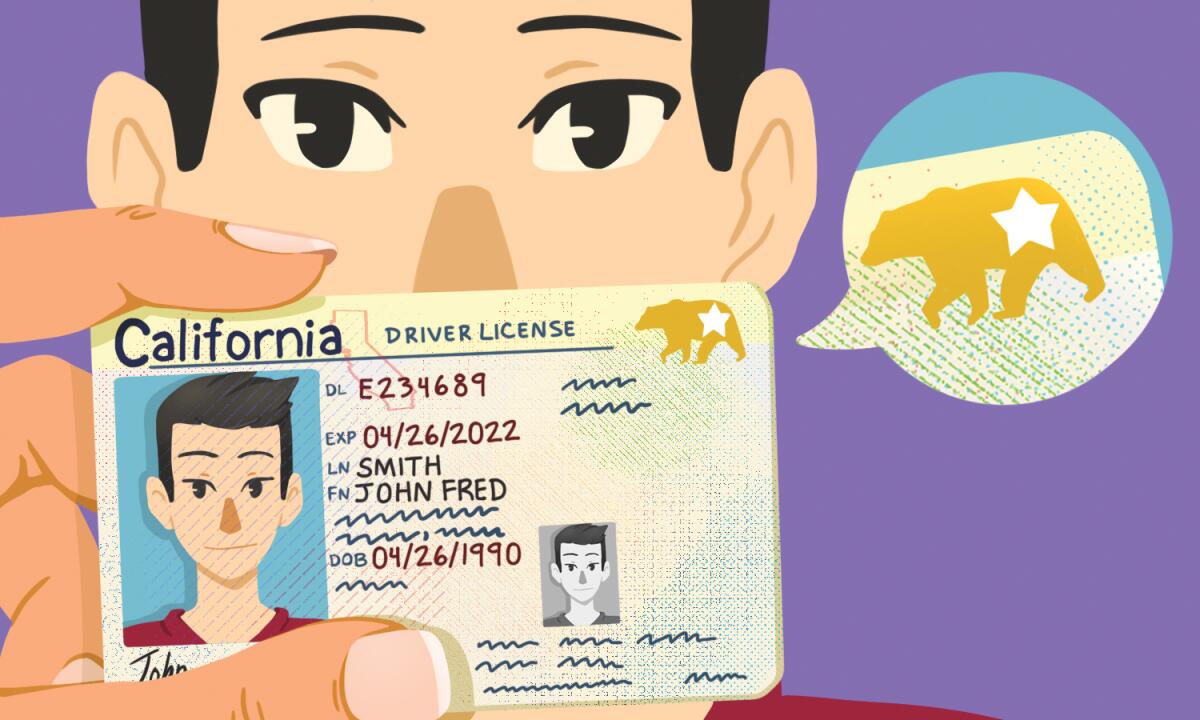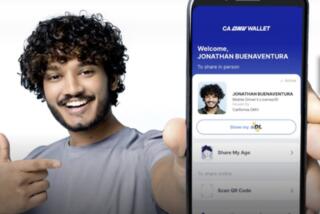Ignore this Real ID story at your peril as the clock ticks toward the deadline

- Share via
If you don’t know what the Real ID driver’s license is, you have plenty of company.
If you still don’t know about it by the end of this column, you may be in a world of hurt if you try to get on an airplane starting Oct. 1, 2020.
If you already have your federally compliant driver’s license, you get a gold star. Literally. We’ll explain that in a bit.
If you don’t know whether you have a federally compliant driver’s license, you probably don’t, because you would remember the pain of going to the Department of Motor Vehicles to get one.
If you don’t know why this matters, this is a good time to find out, because the clock is ticking. And you don’t want to be caught in the mass of people pushing and shoving as time draws nigh.
Here’s why I’m nervous about Real ID and you: Almost three-quarters of Americans either don’t have Real ID or don’t know whether they do, according to a study released this month by the U.S. Travel Assn.
If, on Oct. 1, 2020, you are flying domestically and you expect your regular driver’s license to get you through airport security (and you aren’t carrying another form of compliant identification), you will not be able to board your flight.
Getting the federally compliant license requires you to gather your documentation (California drivers can find what’s needed at RealIDdox), make an appointment and go to the DMV. You apply, your documentation checks out and you get a new license with a bear and a gold star in the upper right corner — that’s how you know you have a Real ID.
The travel association study estimates nearly 80,000 of you could be stopped from catching your flights on the first day this is implemented because you don’t have Real ID (or aren’t carrying another form of acceptable identification), resulting in $40.3 million in lost spending for travel businesses. Play that out for a week, and it’s more than half a million people representing $282 million in lost spending.
To bring this home: If you get turned away at the airport and forget to cancel your flight, you can kiss your airline ticket goodbye.
By now you may be sputtering about why you didn’t know about this. It’s not totally your fault. After all, it’s been 14 years since this mandate was signed into law, and there have been numerous delays and false starts in its implementation.
There’s been “an assumption by folks that this would be extended or pushed back, so folks haven’t taken it as seriously as they should,” said Tori Emerson Barnes, executive vice president of public affairs and policy for the U.S. Travel Assn., which is now communicating this information to the public.
How to do that? We spoke with communications experts who suggested that this message to the public requires:
•A sense of urgency. You know how you put off calculating your taxes until April 15? That’s how people look at getting Real ID. You’re not going to jail if you don’t have Real ID (unlike evading your taxes), but you aren’t going to go anywhere on a domestic flight unless you have it (or another acceptable form of ID, see above).
“The TSA and DHS appear to be relying on FAQs at their websites” to communicate this change, said Ethan Rasiel, chief executive of Lightspeed PR, a New York-based public relations firm that helps clients introduce new technologies. “This isn’t going to be sufficient,” he said in an email.
“To start, they should provide every DMV in the country with clear and concise signage explaining the various types of licenses, and they have to make sure agents are properly aware and trained.
“Just look to the flu shot awareness campaign for an example — it’s almost impossible not to be aware that you need your flu shot.”
•Use every tool in the communications toolbox. “It’s time for a full-court press to get the word out,” said Nico Melendez, formerly a media representative for the Transportation Security Administration. It’s important to use all media — including social media — to let people know, he said.
•Go where travelers are. If you want to let people know about changes, go to travel websites, hotels, travel agents and those who work with business travelers and ask for their help in communicating, said Kevin O’Malley, chairman and chief executive of Travel and Transport, a large corporate travel agency.
•Go where travelers aren’t. This may be the most difficult group to corral, O’Malley said, especially if they are infrequent travelers. It may require a grass-roots effort through banks, institutions that people frequent, clubs, organizations, personnel departments at large companies and so on.
•Reinforcement from voices of authority. Airport TSA officers are telling people who are boarding flights that they need to have a compliant ID, said Jenny Burke, a TSA representative.
•Deemphasize the punitive, said Joshua Dorsey, assistant professor of marketing at Cal State Fullerton. Explain “the benefit to you of why you’d want to have Real ID,” he said. “People do want to travel and want to go places. I can tether the Real ID to something positive that allows me to continue to have a growth experience, I can continue to grow and see other places.”
•Sadvertising. Dorsey was half-joking when he suggested sadvertising, a term with which I wasn’t familiar. “You know those ASPCA ads?” he asked, the ones in which sad-eyed critters need your financial help to avoid terrible fates. I knew immediately and started getting teary-eyed just thinking about them.
You may encounter many of these types of messaging in the coming months (except maybe the sad-eyed cats and dogs). And there’s one more you might consider: word of mouth. Ask your family members. Ask your friends. Because friends and family don’t let their friends and family fly unawares.
Have a travel dilemma, question or problem? Write to [email protected]. We regret we cannot answer every inquiry.
More to Read
Sign up for The Wild
We’ll help you find the best places to hike, bike and run, as well as the perfect silent spots for meditation and yoga.
You may occasionally receive promotional content from the Los Angeles Times.







